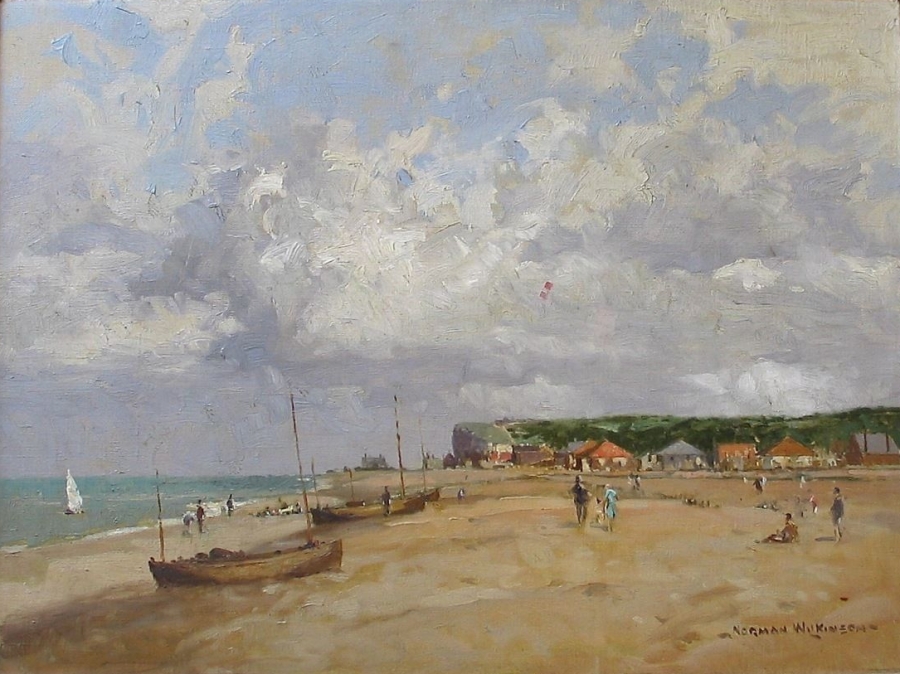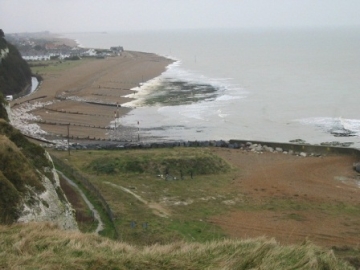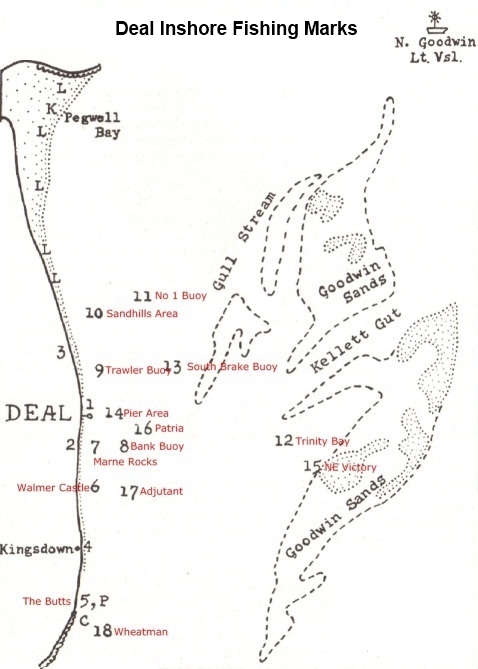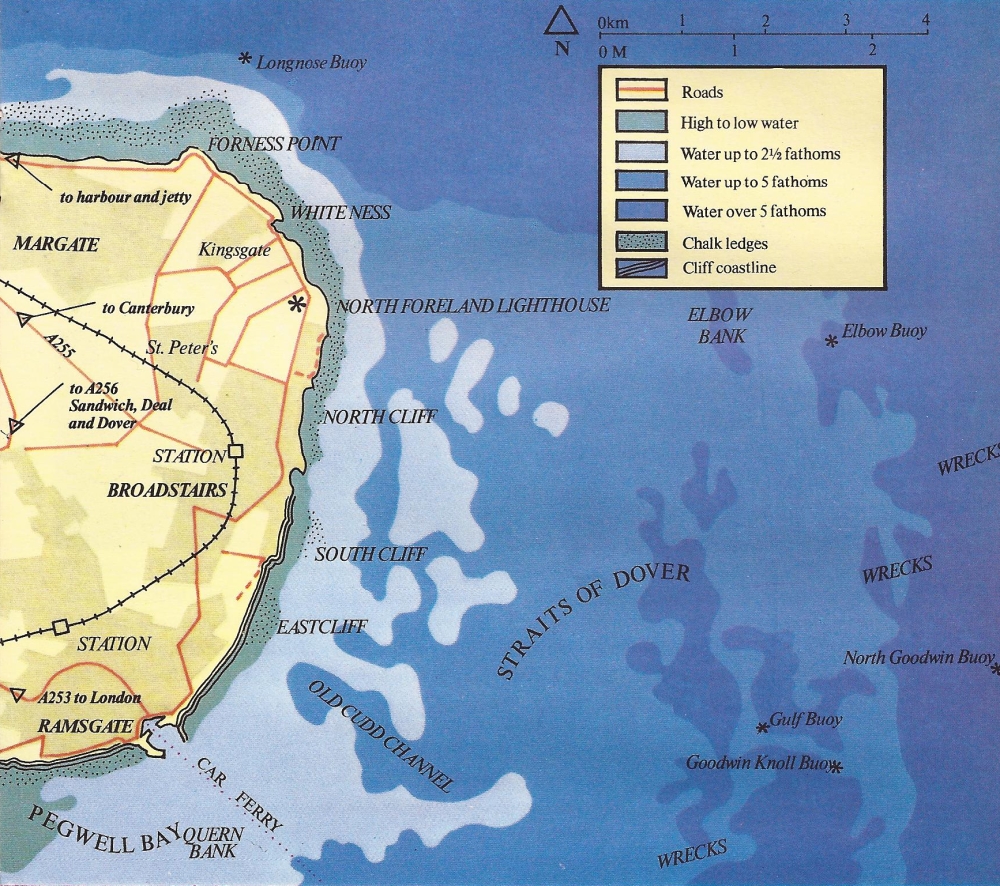 Kent Coast Sea Fishing Compendium |
Kingsdown |

Kingsdown Beach
Norman Wilkinson CBE (1878 – 1971)

Kingsdown Fishing Marks
- on the beach opposite the Zetland Arms (51.186213, 1.40487); sizeable cod, bass, coalfish, whiting and pouting but few, if any, flatties;
- in front of the boat slipway keeping clear of the groynes to the south which provide poor fishing;
- Kingsdown Butts, Oldstairs Bay (51.179910, 1.404751); the area with sea defences (large boulders), is snaggy and is best fished two hours before and two hours after low water from the sea wall of Kingsdown Ranges (MOD property and dangerous) using rotten bottom rigs can produce cod (from the end of October) and Bass (from September). Codling patrol the gullies approximately 30 yards out from the boulders. Recommended baits include lugworm, squid, crab and locals advise that the best catches are on mid-range tides in overcast conditions. Take a net …

"Sea Fishing in Kent" (1973) Hugh Stoker at pages 34, 36 & 40
Shore Fishing
4. Kingsdown Beach. This steeply shelving shingle beach can be reached by turning down towards the sea near the Rising Sun Inn. It is capable of yielding some good bass on occasions, particularly after dark. The best time to start fishing, as a rule, is about 2 hours before H.W. Other species taken include dogfish; also cod (some of them large) from October or November onwards. A two-hook Wessex leger makes a useful terminal rig here; alternatively try a free-running leger with a flowing trace. Recommended baits: yellowtail lug, king ragworm, herring and mackerel strips, and squid.
Incidentally, within living memory Kingsdown beach has begun to recede very rapidly indeed, and local fishermen blame this on the construction of the breakwater at Dover harbour. Certainly something has reversed a process which, over the centuries, deposited acres of shingle in front of the chalk uplands behind Kingsdown village.
5. The Butts, Kingsdown. These butts form part of a firing range which, at the time of writing, is in regular use by the Royal Marines. The road to the butts leads straight on past the Rising Sun Inn, but access is prohibited when the red flag is flying. Firing normally ceases at 4:30 pm on weekdays.
The seaward side of the butts is a popular vantage point with specialist bass anglers, one favourite method being float fishing with a live prawn bait. Best results are obtained around H.W. It is also possible to use herring or mackerel strip, yellowtail lug, a lively ragworm etc., but a live prawn is definitely best. Prawns can be caught here with a baited drop-net when conditions are suitable, but results vary considerably and it is unwise to rely on catching one's bait on the spot.
Some good bass have also been taken at this position by spinning with a rubber eel, a 3 to 4 inch narrow wobbling spoon, and other suitable lures. Spinning with a strip of squid is also worth trying ...
Local Bait Grounds (Chart symbols are shown in brackets)
Peeler and Soft Crabs (C) are most likely to be found during the warmer months around L.W. springs, on rocky and weedy stretches of shore. One likely area is the extensive stretch of rocks bordering the west wall of Ramsgate harbour. Also further round towards Pegwell Bay, where the low tide rocks adjoin softer ground, and among the chalky rocks in the Broadstairs area ... are far from plentiful, but a few may be found around the rocks south of Kingsdown during the warmer months.
Prawns (P) when conditions are suitable, prawns my be caught with a baited drop-net from the Butts, at Kingsdown.
"Sea Angling Hotspots" (1974) Hugh Stoker at page 119
... it can be downright dangerous to go rock fishing on a lonely stretch of coast by oneself. Alone, or in company, make it a rule never to take risks. Remember, it is so much easier to fall off a slippery rock than to climb back on it !
"Fisherman's Handbook" (1977) The Marshall Cavendish, Part 9 at pages 231 to 235
The Kent Coast

Map showing the sand banks and wrecks where fine cod and conger are fished
The Kent coast offers some of the finest sea angling in the British Isles. Many species are encountered with cod predominant, particularly during the autumn and winter. The great advantage of fishing this coastline is that excellent fishing can often be had only a mile or two beyond the embarkation point.
The North Sea, ebbing and flowing through the Straits of Dover, gives rather fierce tides, but the relatively shallow water compensates for this. Rarely is it over 14 fathoms deep, and is on average 7-10 fathoms. There is good fishing up the Thames as far as Gravesend and the Isle of Sheppey but this is estuary fishing. Open sea fishing begins at Whitstable.
Whitstable is reached directly from London via the M2 and A299. The sea around this town is shallow for the first five miles out, and on average less than three fathoms deep. Boat anglers can expect to find dabs, whiting and cod in winter, and flounders, eels and bass in summer. Shore anglers enjoy beachcasting for the same species from the gentle shelving beach east of the harbour.
Herne Bay lies 4 miles to the east of Whitstable still on the A299. Several available charter boats will take anglers to the famous Pansands for the excellent bass fishing in the summer, or to the broken ground off Reculver for winter cod fishing.The town was famous for its tope fishing before the war, but this species seems to have declined since then. The average depth here is about 3 fathoms until one reaches the shipping lanes nearly 7 miles out.
Most varieties of seafish are caught in the appropriate seasons with thornback ray and smooth-hounds especially prolific during the peeler crab season in April, May and June. For the shore angler, fishing from the Eastern Promenade can be very rewarding, particularly in the autumn and winter after dark. Unfortunately the ¾ mile long pier was closed as being unsafe in 1968.
Good fishing
The twin towers of the ruined church known as Reculver are 3 miles east of Herne Bay. The beach here shelves gently. and thornback and stingrays are caught during spring and summer and cod and whiting in autumn and winter. Shore angling is good for another 2 miles east of this landmark.
Several charter boats are on hire from the harbour at Margate. The water here is 5-6 fathoms deep and the bottom, except at Margate Sands, is of chalk and flints, unlike the sand and gravel bottom at Herne Bay. Excellent bass and thornback ray are caught during spring and summer. The North Foreland Lighthouse is south-east of Margate, and the Elbow Buoy is approximately three miles out at sea from this point. Here one can expect the finest cod fishing to be had in the British Isles.
Many dinghy anglers favour the Longnose Buoy which is nearer, being a mile offshore, and where similar catches can be made. During the summer, bass fishing is good off the inshore chalk ledges and artificial lures are very successful. In the town there is a stone jetty and promenades from which most varieties can be taken depending on the season.
Broadstairs, on the A225 about 4 miles south-east of Margate, has a harbour where boats can be chartered to fish the same area as the Margate boats. Shore angling is possible from the harbour arm and from the chalk ledges north and south of the town.
Ramsgate, south of Broadstairs, is on a direct route from London via the M2, A222 and A253. With its very large harbour and excellent boat facilities, it accommodates both individual and charter anglers. The boats fish as far as the Elbow Buoy, particularly in winter for the cod, at North Goodwins for thornback ray during the summer months, and at Quern Bank for the good bass fishing. Pegwell Bay, which is a shallow water mark, is good for flatfish and whiting. Shore angling takes place from the harbour arms and a large variety of fish are caught although the ground is rather snaggy from the western arm. Large shoals of mullet abound inside the harbour during the summer months and can be caught on freshwater tackle. Other shore stations include the Chines and Under-Cliffe.
Sand and shingle
Although Sandwich lies a mile inland from the coast there is a road through the sand dunes to the shore. The chalk of Ramsgate has now given way to sand and shingle and excellent sport can be had by the beach angler from this point. Big catches of cod are made during the autumn and winter, and mainly flatfish, including soles, through the summer.
South of Ramsgate, and accessible via the M2, the A257 and the A258, Deal is the Mecca of sea angling. Large numbers of charter boats are launched from the steeply-shelving shingle beaches and just about every species of seafish has been caught at some time in these waters. A number of wrecks, particularly on the Goodwin Sands, provide good conger fishing, and in the summer tope and thornback are still caught in fair numbers over the sands. There is often good plaice fishing north of the town and south of Kingsdown, but the town's reputation is primarily for winter cod and whiting. Angling is allowed throughout the year from the modern pier and also night fishing at weekends.
Known as the gateway to England, Dover boasts a magnificent harbour with several angling charter boats. This is the narrowest part of the English Channel and the tides are therefore the strongest, but on neap tides the fishing is good, particularly for conger, cod and pollack found among the many wrecks. The water here is deeper than the rest of the Kent Coast and the bottom is very hard chalk with fissures. Varne Bank, lying nearly half-way across the Channel, can provide good cod fishing throughout the summer with brill and turbot often a bonus. For the shore angler, the large harbour gives plenty of opportunity, although the eastern arm was closed to anglers many years ago. The Southern Breakwater is only accessible by boat, but a ferry service will take anglers for a nominal charge. Admiralty Pier is free fishing and anglers will often be shoulder to shoulder feathering for the vast shoals of mackerel found here during the summer.
Folkestone
Folkestone Harbour, approximately 5 miles west of Dover, has charter boats which fish Varne Bank in summer and supply good inshore fishing in winter. Several of the inshore marks have 14 fathoms of water, and the sea bed is very rocky particularly off the Warren. Conger to 30 lb are not uncommon near the British Rail Harbour Arm where anglers may fish for a small charge. West of Folkestone, the first mile of shingle beach runs off to snaggy ground, and further westward gives way to sand. This beach extends for 4½ miles, and the road at the top known as Princes Parade enables one virtually to fish from the car. Many species are caught here including bass, conger, plaice, cod and whiting. West of Hythe are the Military Ranges, where fishing is prohibited except on special occasions.
Dungeness is reached via the A259 to New Romney, then the B2071 out to the point. From Hythe to Dungeness the tide goes out so far that very little beachfishing is possible, but at Dungeness itself the steep shelving beach of shingle and the deep water make it ideal for the beach angler. Many years ago Leslie Moncrieff made this station famous for its cod fishing during the winter months. With the right conditions, anglers catch more cod than they can carry, and many of them are over 20 lb. In summer Dungeness and Dengemarsh provide excellent sole fishing and quite often large shoals of mackerel come right to the water's edge. Nearly all species of seafish are contacted; at one time there was even a small thresher shark caught from the beach here.
"Sea Angling: Kent to Cornwall" (1990) Mel Russ & Alan Yates at page 24
Kingsdown and St. Margarets Bay are marks where rock anglers search for bass, cod and occasionally big conger eels. Kingsdown Butts, as its name suggests, is an army rifle range. Fishing is available when the Butts are not in use, with fishing from the cliff protection aprons. Essentially a venue of the autumn and winter, although not known nationally because of its constant use by the Army, local anglers spot that firing has ceased and take the opportunity to fish. Cod to 30lb have been caught from the Butts and in recent years a best conger of 52lb was landed in the autumn. Access is via the B2057 off the Dover to Deal road. The Butts fishes best at low water with peeler crab, yellowtail and occasionally a large squid bait being the most productive. Farther along the coast St. Margarets Bay offers similar conditions, although angling space is limited and not possible in summer when the venue is crowded with holidaymakers.
"Sea Angling: Kent to Cornwall" (1990) Mel Russ & Alan Yates at pages 34 & 35
Kent Alan Yates
Boat angling guide to the Kent coast
Deal, with nearby Walmer, are both home to a large charter fleet of craft launched from the beach. Positioned in the lee of the prevailing south-westerly winds, boats in the area are very seldom prevented from going to sea, although beach launching can be difficult in a strong south-westerly swell. Excellent fishing is enjoyed during the winter, especially with cod. Marks are within two miles of the shore, whilst during the summer months the Goodwin Sands are easily reached. Fish the Goodwins during an ebb tide run-off with a flowing trace and hook baited with fish to attract tope, thornback, dogfish and bass. Winter cod respond best to yellowtail lugworm and large squid baits, also fished on a flowing trace.
To the west of Deal, marks off Kingsdown and Fan Bay, near Dover, are known for their good cod and plaice fishing within one mile of the shore. There are a considerable number of wrecks within easy reach of the Deal and Walmer boats, and hauls consist of cod, conger and pollack with feathers, pirks and artificial eels all scoring well, especially for the cod. Dinghy anglers should head for the Kingsdown SAC, where there's excellent launching facilities close to the Zetland Arms at Kingsdown. Inshore dinghy fishing under the White Cliffs of Dover is excellent for cod in winter and bass and plaice in summer.